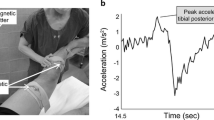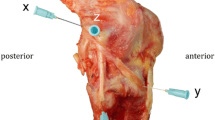Abstract
Purpose
We aimed to quantify the effect of changes in tibial slope on the magnitude of anterior tibial translation (ATT) in the anterior cruciate ligament (ACL)-deficient knee during the Lachman and mechanized pivot shift tests. We hypothesized that increased posterior tibial slope would increase the amount of ATT of an ACL-deficient knee, while leveling the slope of the tibial plateau would decrease the amount of ATT.
Methods
Lachman and mechanized pivot shift tests were performed on hip-to-toe cadaveric specimens, and ATT of the lateral and the medial compartments was measured using navigation (n = 11). The ACL was then sectioned. Stability testing was repeated, and ATT was recorded. A proximal tibial osteotomy in the sagittal plane was then performed achieving either +5 or −5° of tibial slope variation after which stability testing was repeated (n = 10).
Results
Sectioning the ACL resulted in a significant increase in ATT in both the Lachman and mechanized pivot shift tests (P < 0.05). Increasing or decreasing the slope of the tibial plateau had no effect on ATT during the Lachman test (n.s.). During the mechanized pivot shift tests, a 5° increase in posterior slope resulted in a significant increase in ATT compared to the native knee (P < 0.05), while a 5° decrease in slope reduced ATT to a level similar to that of the intact knee.
Conclusions
Tibial slope changes did not affect the magnitude of translation during a Lachman test. However, large changes in tibial slope variation affected the magnitude of the pivot shift.




Similar content being viewed by others
References
Agneskirchner JD, Hurschler C, Stukenborg-Colsman C, Imhoff AB, Lobenhoffer P (2004) Effect of high tibial flexion osteotomy on cartilage pressure, joint kinematics: a biomechanical study in human cadaveric knees. Winner of the AGA-DonJoy Award 2004. Arch Orthop Trauma Surg 124(9):575–584
Boden BP, Breit I, Sheehan FT (2009) Tibiofemoral alignment: contributing factors to noncontact anterior cruciate ligament injury. J Bone Joint Surg Am 91(10):2381–2389
Boden BP, Sheehan FT, Torg JS, Hewett TE (2010) Noncontact anterior cruciate ligament injuries: mechanisms and risk factors. J Am Acad Orthop Surg 18(9):520–527
Boss A, Stutz G, Oursin C, Gachter A (1995) Anterior cruciate ligament reconstruction combined with valgus tibial osteotomy (combined procedure). Knee Surg Sports Traumatol Arthrosc 3(3):187–191
Brandon ML, Haynes PT, Bonamo JR, Flynn MI, Barrett GR, Sherman MF (2006) The association between posterior-inferior tibial slope and anterior cruciate ligament insufficiency. Arthroscopy 22(8):894–899
Brophy RH, Voos JE, Shannon FJ, Granchi CC, Wickiewicz TL, Warren RF, Pearle AD (2008) Changes in the length of virtual anterior cruciate ligament fibers during stability testing: a comparison of conventional single-bundle reconstruction and native anterior cruciate ligament. Am J Sports Med 36(11):2196–2203
Citak M, Suero EM, Rozell JC, Bosscher MR, Kuestermeyer J, Pearle AD (2010) A mechanized and standardized pivot shifter: technical description and first evaluation. Knee Surg Sports Traumatol Arthrosc 19(5):707–711
Colombet P, Robinson J, Christel P, Franceschi J-P, Djian P (2007) Using navigation to measure rotation kinematics during ACL reconstruction. Clin Orthop Relat Res 454:59–65
Dejour H, Bonnin M (1994) Tibial translation after anterior cruciate ligament rupture. Two radiological tests compared. J Bone Joint Surg Br 76(5):745–749
Demange MK, Camanho GL, Pecora JR, Gobbi RG, Tirico LE, Albuquerque RF (2010) Simultaneous anterior cruciate ligament reconstruction and computer-assisted open-wedge high tibial osteotomy: a report of eight cases. Knee 18(6):387–391
Fening SD, Kovacic J, Kambic H, McLean S, Scott J, Miniaci A (2008) The effects of modified posterior tibial slope on anterior cruciate ligament strain and knee kinematics: a human cadaveric study. J Knee Surg 21(3):205–211
Giffin JR, Stabile KJ, Zantop T, Vogrin TM, Woo SL, Harner CD (2007) Importance of tibial slope for stability of the posterior cruciate ligament deficient knee. Am J Sports Med 35(9):1443–1449
Giffin JR, Vogrin TM, Zantop T, Woo SL, Harner CD (2004) Effects of increasing tibial slope on the biomechanics of the knee. Am J Sports Med 32(2):376–382
Hudek R, Schmutz S, Regenfelder F, Fuchs B, Koch PP (2009) Novel measurement technique of the tibial slope on conventional MRI. Clin Orthop Relat Res 467(8):2066–2072
Jakob RP, Staubli HU, Deland JT (1987) Grading the pivot shift. Objective tests with implications for treatment. J Bone Joint Surg Br 69(2):294–299
Jonsson H, Riklund-Ahlstrom K, Lind J (2004) Positive pivot shift after ACL reconstruction predicts later osteoarthrosis: 63 patients followed 5–9 years after surgery. Acta Orthop Scand 75(5):594–599
Kocher MS, Steadman JR, Briggs KK, Sterett WI, Hawkins RJ (2004) Relationships between objective assessment of ligament stability and subjective assessment of symptoms and function after anterior cruciate ligament reconstruction. Am J Sports Med 32(3):629–634
Lane CG, Warren R, Pearle AD (2008) The pivot shift. J Am Acad Orthop Surg 16(12):679–688
Lane CG, Warren RF, Stanford FC, Kendoff D, Pearle AD (2008) In vivo analysis of the pivot shift phenomenon during computer navigated ACL reconstruction. Knee Surg Sports Traumatol Arthrosc 16(5):487–492
Lohmander LS, Englund PM, Dahl LL, Roos EM (2007) The long-term consequence of anterior cruciate ligament and meniscus injuries: osteoarthritis. Am J Sports Med 35(10):1756–1769
Markolf KL, Jackson SR, McAllister DR (2010) Relationship between the pivot shift and Lachman tests: a cadaver study. J Bone Joint Surg Am 92(11):2067–2075
Musahl V, Ayeni OR, Citak M, Irrgang JJ, Pearle AD, Wickiewicz TL (2010) The influence of bony morphology on the magnitude of the pivot shift. Knee Surg Sports Traumatol Arthrosc 18(9):1232–1238
Musahl V, Voos J, O’Loughlin PF, Stueber V, Kendoff D, Pearle AD (2010) Mechanized pivot shift test achieves greater accuracy than manual pivot shift test. Knee Surg Sports Traumatol Arthrosc 18(9):1208–1213
Neuschwander DC, Drez D Jr, Paine RM (1993) Simultaneous high tibial osteotomy and ACL reconstruction for combined genu varum and symptomatic ACL tear. Orthopedics 16(6):679–684
Pearle AD, Kendoff D, Musahl V, Warren RF (2009) The pivot-shift phenomenon during computer-assisted anterior cruciate ligament reconstruction. J Bone Joint Surg Am 91(Suppl 1):115–118
Rodner CM, Adams DJ, Diaz-Doran V, Tate JP, Santangelo SA, Mazzocca AD, Arciero RA (2006) Medial opening wedge tibial osteotomy and the sagittal plane: the effect of increasing tibial slope on tibiofemoral contact pressure. Am J Sports Med 34(9):1431–1441
Terauchi M, Hatayama K, Yanagisawa S, Saito K, Takagishi K (2011) Sagittal alignment of the knee and its relationship to noncontact anterior cruciate ligament injuries. Am J Sports Med 39(5):1090–1094
Todd MS, Lalliss S, Garcia E, DeBerardino TM, Cameron KL (2010) The relationship between posterior tibial slope and anterior cruciate ligament injuries. Am J Sports Med 38(1):63–67
Voos JE, Musahl V, Maak TG, Wickiewicz TL, Pearle AD (2010) Comparison of tunnel positions in single-bundle anterior cruciate ligament reconstructions using computer navigation. Knee Surg Sports Traumatol Arthrosc 18(9):1282–1289
Williams RJ 3rd, Kelly BT, Wickiewicz TL, Altchek DW, Warren RF (2003) The short-term outcome of surgical treatment for painful varus arthritis in association with chronic ACL deficiency. J Knee Surg 16(1):9–16
Author information
Authors and Affiliations
Corresponding author
Rights and permissions
About this article
Cite this article
Voos, J.E., Suero, E.M., Citak, M. et al. Effect of tibial slope on the stability of the anterior cruciate ligament–deficient knee. Knee Surg Sports Traumatol Arthrosc 20, 1626–1631 (2012). https://doi.org/10.1007/s00167-011-1823-3
Received:
Accepted:
Published:
Issue Date:
DOI: https://doi.org/10.1007/s00167-011-1823-3




